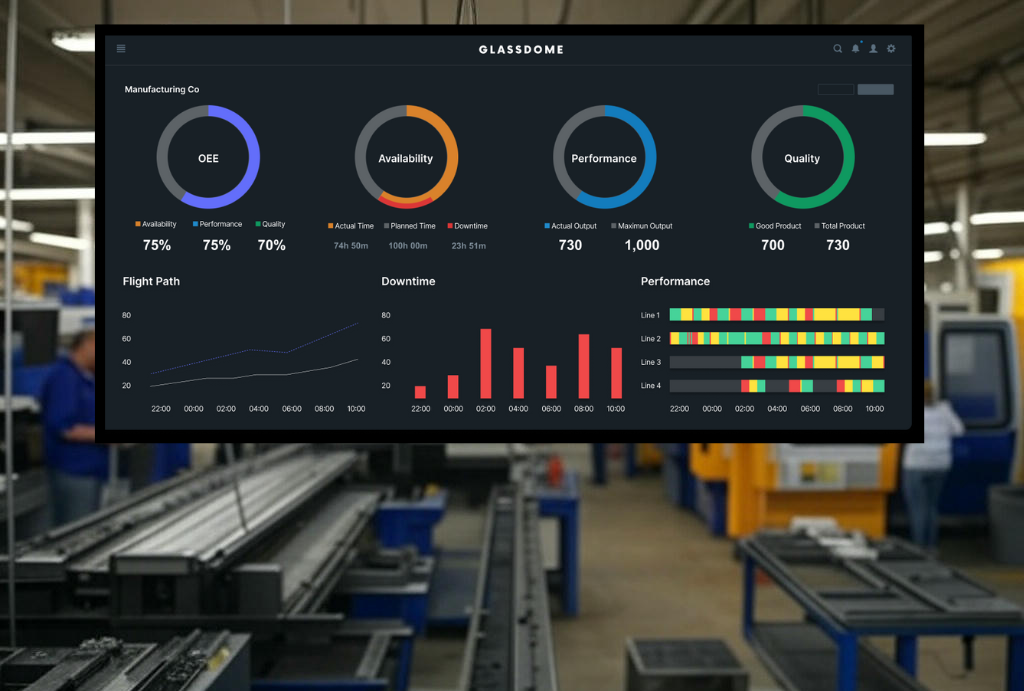Return on Data: A New Way of Thinking About Manufacturing Investment
By Max Krevitz
Return on Data is the value that business derives from its data, subtracting the resources invested in acquiring, managing, and using that data.
Data is an asset you already have. It’s sitting around your factory, lurking in your power bills, erased each morning on a whiteboard after a shift.
Companies have a firm understanding that “when I spend X on a machine, it will do Y.” With software that correlation is not nearly as direct. But not getting a return on data is a hidden cost.
You aren’t using something that could be helping your company be more innovative, distinctive, and efficient. It’s like a piece of unique intellectual property going unused, unhappy workers with untapped potential, or a brand with no market presence. You can’t see it on your balance sheet, but you’re missing out.
Why is Return on Data important?
Within the global manufacturing economy, buzzwords like Digital Transformation, IoT, Digital Twin, and Smart Factory have translated into costly initiatives without a well-defined understanding of their Return on Investment (ROI).
As Glassdome Chief Business Officer (and nuclear engineering PhD) Jinki Ham says, “A Tier 1 manufacturer can invest millions of dollars in new machinery, sensors, IOT, and software, but if you can’t find and use the correct data, your ROI will be zero.”
While ROI has been the traditional accounting metric for manufacturers when purchasing a new machine or investing in frontline worker operations, ROD has emerged as a crucial metric for investment analysis.
Any operations manager will tell you that there is no silver bullet purchase to increase production output or efficiency. This reality is amplified for the small/mid sized manufacturing operation. And that lack of clear attribution gets in the way of getting new line items approved.
For a manufacturer with a hundred employees, a tightly guarded op-ex budget can become an operations manager’s greatest hindrance to continuous improvement goals. By emphasizing the Return on Data, and the relatively small cost* of manufacturing software to activate a potentially enormous asset, an operations manager can defend their budget, and use their findings to argue it should be increased.
*The Glassdome Production Monitoring Foundation tier is available for under $10,000.
When should I use Return on Data?
Let’s visualize a real example of when a business might use ROI vs. ROD.
In this scenario a manufacturer has noticed a machine downtime failure rate of 25% at one station, far greater than 5 identical stations on the same line. The operations manager has the experience necessary to guess that a poorly trained worker is at fault, but cannot prove it. Here are a few paths the operations manager considered to solve the issue.
- Hire a Lean Six Sigma consultant to analyze the failure: estimated cost $10,000 a week.
- The OEM has agreed to repair or replace the machine if broken. Take advantage of that offer, but incur 100% downtime costs for installation: Time for installation: 4 weeks, with no guarantee of decreased downtime. Total loss of production while the machine is down: $100,000.
- Keep the line running at full capacity while investing in a production monitoring software* for $5,000 – $20,000 upfront. This will confirm or deny his suspicion that the front line worker is not properly maintaining the machinery. This software can also be used to monitor all of the other lines in the facility for the same subscription fee, with no additional costs as it scales.
The Glassdome Production Monitoring platform is a great choice for this, with real-time monitoring, customized dashboards, and automated reporting.
Another use case for Return on Data is investment analysis.
While ROI evaluates overall financial returns, ROD specifically assesses the impact of leveraging data as an asset. Data is not a one time investment that only improves individual metrics, like a consultant or piece of machinery. Data is an asset that grows in value exponentially when it is gathered and cultivated. While a consultant or piece of machinery might solve a problem, a data pipeline is an asset that can tell you why the problem is happening right now, and solve multiple issues over time.
So what does this mean for a manufacturer who has a limited budget and opaque operations failures? Look to the data!
Ready to start seeing a Return on Data at your factory?
Talk to a Glassdome manufacturing expert


